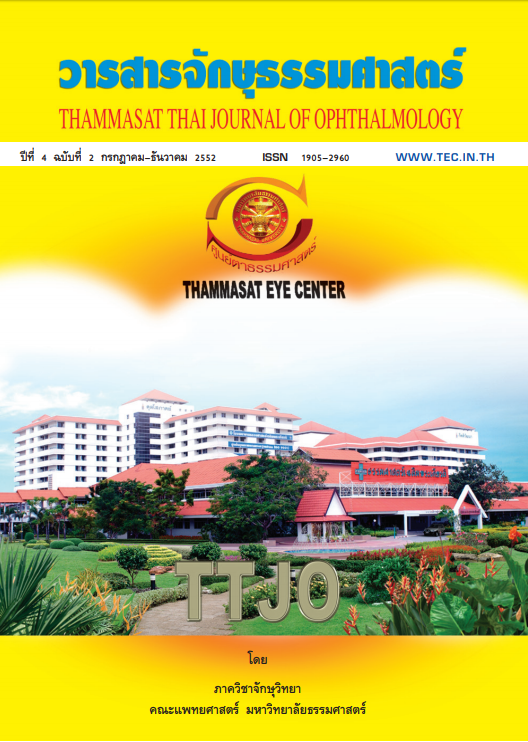A Live Intravitreal Thelazia Spp. with Diffuse Unilateral Subacute Neuroretinitis
Main Article Content
Abstract
Thelaziasis เป็นภาวะการติดเชื้อพยาธิตัวกลม Thelazia Spp. โดยเฉพาะอย่างยิ่ง Thlazia Callipaeda จากการรวบรวมรายงานผู้ป่วยพบว่า มีกรติดเชื้อชนิดนี้ในตามนุษย์ในพื้นที่ต่างๆทั่วโลก ได้แก่ ประเทศไทย, จีน, อินเดีย, ญี่ปุ่น, เกาหลี, อิตาลี และประเทศแถบยุโรปเหนือ จึงทำให้พยาธิชนิดนี้มีชื่อเรียกอีกชื่อว่า Oriental round worm พยาธิชนิดนี้จะมีการเจริญเป็นตัวเต็มวัยใน conjunctival sac, lacrimal gland และ lacrimal duct ของสัตว์หลายชนิด (definite host) ได้แก่ สุนัข, แมว, กระต่าย, วัว, กวาง และลิง เป็นต้น ส่วนการติดต่อมาสู่มนุษย์ เกิดจากการที่แมลงวันบ้านในตระกูล Drosophilia Spp. (intermediate host) ไปตอมและดูดกินน้ำตาของสัตว์ที่มีเชื้อทำให้ได้รับไข่หรือตัวอ่อนของพยาธิ จนมีการเจริญไปเป็นตัวอ่อนระยะที่ 3 เมื่อแมลงวันพาหะนี้ไปตอมตาผู้ป่วย จึงทำให้เกิดการแพร่เชื้อสู่มนุษย์ (accidental host) ได้ จากรายงานผู้ป่วยส่วนใหญ่ ผู้ป่วยที่ได้รับเชื้อมักจะมีอาการระคายเคืองตา น้ำตาไหลจากการที่มีตัวอ่อนของพยาธิอยู่นอกลูกตา ได้แก่ บริเวณ conjunctival cul de sac หรือใน lacrimal duct แต่มีบางรายงานที่พบว่า มีการเลื่อนตัวของตัวอ่อนเข้าในลูกตาก่อให้เกิด intraocular infestion จนทำให้ผู้ป่วยมีการมองเห็นลดลง รายงานผู้ป่วยนี้รายงานการตรวจพยาธิตัวกลม Thlazia Spp. ที่ยังมีชีวิตเคลื่อนไหวอยู่ใยย้ำตาวุ้นร่วมกับภาวะ diffuse unilateral subacute neuroretinitis
A Live Intravitreal Thelazia Spp. with Diffuse Unilateral Subacute Neuroretinitis
Thelazia Spp. is a spiruroid nematode which is the causative organism in thalaziasis. It commonly affects the external eye such as conjuctival cul de sac and lacrimal duct. We report the case of a 50-year-old Thai woman presenting with painless blurring of vision over her right eye. The examination shows a live intravitreal nematode with diffuse RPE alteration. We performed Nd-YAG laser to the nematode and then transcleral surgical removal respectively. Finally the nematode was identified as Thelazia Spp. by a parasitologist.
Article Details
References
ประยงค์ ระดมยศ, อัญชลี ตั้งตรงจิตร, ศรีวิชา ครุฑสูตร, พลรัตน์ วิไลรัตน์, ศรชัย หลีอารีย์สุวรรณ. Atlas of Medical Parasitology 7th edition. กรุงเทพฯ: สำนักพิมพ์ เมดิคอล มีเดีย, 2547.
Yospaiboon Y, Sithithavorn P, Maleewong V, Ukosanakarn U, Bhaibulaya M. Ocular thelaziasiz in Thailand: a case report. J Med Assoc Thai 1989;72:469-73.
Cheung WK, Lu HJ, Liang CH, Peng ML, Lee HH. Conjunctivitis caused by thelazia callipaeda infestation in a woman. J Formos Med Assoc 1998;97:425-7.
Nath R, Narain K, Saikia L, Pujari BS, Thakuria B, Mahanta J. Ocular theaziasis in Assam: A report of two cases. Indian J Pathol Microbiol 2008;51:146-8.
Koyama Y, Ohira A, Kono T, Yoneyama T, Shiwaku K. Five case of thelaziasis. Br J Ophthalmol 2000;84:441.
Yagi T, Sasoh M, Kawano T, Ito K, Uji Y, Ando K. Removal of Thelazia callipaeda from the subconjunctival space. Eur J Ophthalmol 2007;17:266-8.
Hong ST, Park YK, Lee SK. et al. Two human cases of Thelazia callipaeda infection in Korea. Korean J Parasitol 1995;33:139-44.
Otranto D, Dutto M, Human thelaziasis, Europe. Emerg Infect Dis 2008;14:647-9.
Xue C, Tian N, Huang Z. Thalazia callipaeda in human vitreous. Can J Ophthalmol 2007;42:884-5.
Zakir R, Zhong-xia Z, Chioddini P, Canning CR. Intraocular infestation with the worm, Thelazia callipaeda. Br J Ophthalmol 1999;83:1194-5.


